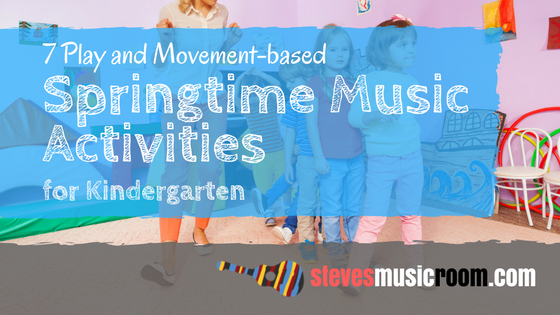7 Play and Movement-based Springtime Music Activities for Kindergarten
- Steve Giddings
- Apr 15, 2018
- 4 min read
Updated: Mar 10, 2023
It is that time of year again where music teachers and classroom Kindergarten teachers alike are looking for Spring activities for their youngest learners. As we know, Kindergarteners learn best through play and movement. The following activities is guaranteed to have them playing or moving in some way:

7 Springtime Music Activities for Any Kindergarten Teacher
These activities are designed in such a way to give you an idea of how they might look in my classroom. You can adapt them for your classroom depending on your preferences.
1. Planting Seeds – I use this song to talk about the lifespan of seeds and the role of farmers. We get into 2 groups and act it out! One group are the ‘seeds’ and the other are the ‘farmers.’ The plants start as seeds and grow slowly at the part where the song says “grow and grow and grow.” At the end, they go back down into the ground to start again. The ‘farmers’ are the ones doing all the work. First they start by planting seeds and bulbs then wait for the seeds to grow and then pick them. The song gives a pretty good idea of how this should go!
2. Rain Storm – For this activity, I have learners sit in a circle and pass out mallets. We first use the but end of the mallets on the floor to make some light rain sounds. Then, we turn them around to simulate heavy rain. They are pretty good at trying to imagine in their brains that it sounds like rain. Once we have this we figure out how to make it sound like a real rain storm by having it start light, then fade to heavy and back again then it goes away. Once we have figured this out, we find a way to add thunder to our storm using instruments they see in the classroom. Perhaps you have a thunder-tube or thunder drum you could use. We just find the biggest drums and cymbals to make our thunder. Great one for ABA form.
3. Worms (music from Spotlight on Music for Kindergarten) – We dance to this song and come up with actions together. Lots of wiggling and squiggling.
4. Vivaldi’s Spring (first 1:15) – There is so much great teaching material in the first 1 minute of this piece. I have my learners use colourful ribbons to show loud and soft in the first section of the tune. In the B section, I have them imagine that they are butterflies and bugs coming out of their hiding places for the first time with or without their ribbons. They show, through movement, how the bugs are moving and reacting. For music teachers, this is perfect for teaching form (AABA) as well as loud and soft. Whether you are a classroom teacher or a music teacher, this can show how a story can be told through music without using words and what spring is all about.
5. Rimsky Korsakov’s Flight of the Bumblebee – This can be used if you have ‘bug’ puppets or ribbons. I have them imagine their puppet or ribbon is a bumblebee and they try to follow the path the bumblebee is taking. Can be used to reinforce high and low or fast/slow as well. There is room for discussion about what the bumblebee is doing.
6. Oats, Peas, Beans, and Barley – This one is slightly different from the one I use from Spotlight on Music but it gets the point across. We do this one in a circle like in the video but you can change your actions to your liking. We like to have a discussion about what oats, peas, beans, and barley actually are. I find pictures online to show them. If you have dried ones in your classroom, this is even better!
7. Little Ducky Duddle – You may have your own version of this song, I have it in the Spotlight on Music Kindergarten book and resources. The video is just to show you the song. I have them sing the song in a circle (forming a puddle), keeping the beat to begin, changing it up every few measures. Once they are comfortable I have them join me with claps on the Quacks or where they think the Quacks are [implied] in the music. The next step would be to add instruments. This is a great way to learn instrument names in the process. I have drums become the quacks and another instrument keep the beat then we switch. We sometimes change up the instruments and I try to make sure they are singing while they are trying to keep the beat and play their instruments. Another step after this is to have one person volunteer to be Ducky Duddle by sitting in the middle of the circle (the puddle) and sing the first half of the song alone. After the instrumental break (assuming you have the recording from Spotlight) everyone joins in with the singing. There is so much we can do with this.
I hope these activities help you with your Spring activities for your young learners. As well, you might find other ways to incorporate movement into these activities or make them fit your teaching style. Please let me know your ideas that you have, either for these songs or others. I would love to hear about what you are doing in your classrooms.
Happy Musicking!








Comments